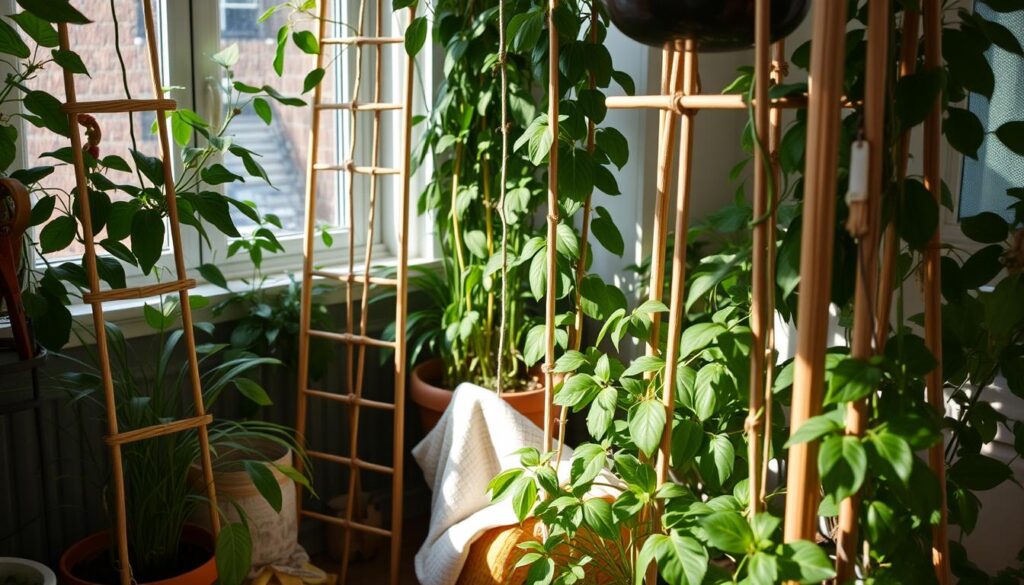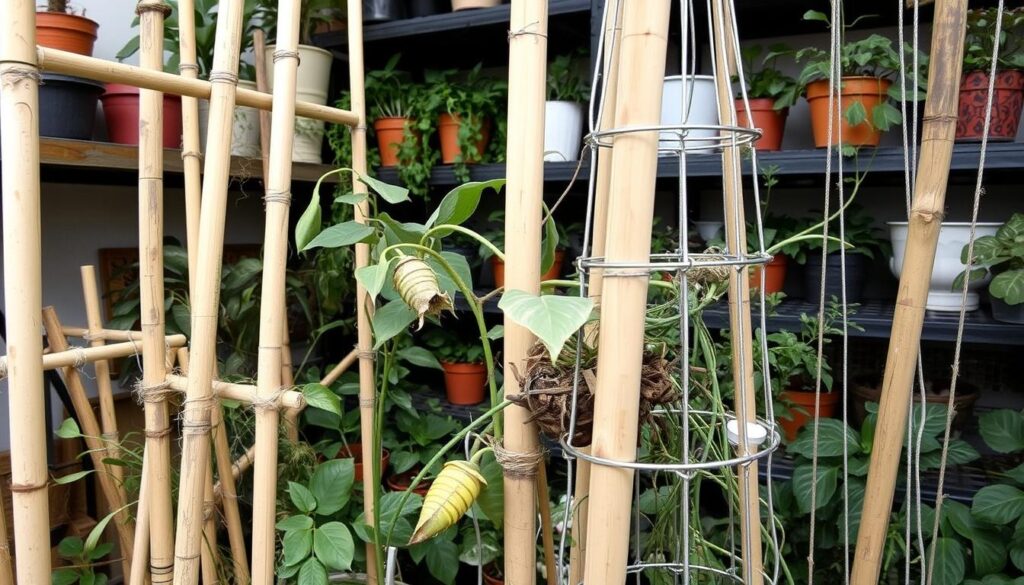Did you know that nearly 80% of indoor plants need support? Many gardeners think plants can grow on their own. But, support structures are key for your plants’ health and looks. This guide will show you the different types of support systems for indoor gardening.
Learning about plant support systems can make your indoor garden thrive. Whether you want to try DIY or follow expert advice, this guide will help. It’s all about making your indoor gardening better.
Key Takeaways
- Indoor plant support structures are essential for healthy growth.
- Understanding different types of support systems enhances gardening success.
- DIY options can be cost-effective and fun to create.
- Regular care and maintenance extend the life of support structures.
- Proper selection of support systems can optimize indoor space.
- Aesthetic choices can integrate support structures into home decor.
Understanding Indoor Plant Support Structures
Indoor plant support structures are key for plant growth. They help plants grow tall and wide, especially for climbing and sprawling types. These supports keep plants in shape and ensure they get enough sunlight, vital for indoor gardeners.
What Are Support Structures?
Support structures include trellises, stakes, and cages. They help plants grow up instead of spreading out. The right support depends on the plant’s needs.
Why Are They Important for Plant Growth?
Support structures are very important for plants. They keep plants stable, preventing damage and improving health. They let plants grow naturally, reaching for sunlight without struggling.
| Support Structure Type | Function | Best For |
|---|---|---|
| Trellis | Provides support for climbing plants | Vines and climbing flowers |
| Stakes | Offers vertical support for stems | Tall plants like tomatoes and peppers |
| Cages | Surrounds plants for comprehensive support | Indeterminate varieties of tomatoes |
Types of Indoor Plant Support Structures
Different support structures meet various plant needs, making indoor gardening better. Choosing the right support is key for your plants’ health and look.
Trellises and Arbors
Plant trellises are great for indoor plant climbers. They let vines and climbing plants grow well. Trellises also improve air flow and sunlight for plants.
Arbors add beauty, turning support into a room highlight. They make any space more interesting.
Stakes and Poles
Plant stakes keep plants upright, stopping them from bending or breaking. Poles help taller plants like monstera or philodendron grow. They are crucial for keeping plants strong.
Plant Rings and Frames
Plant rings and frames support wide plants, keeping them in shape. They balance support and beauty, perfect for bushy plants. They help plants grow up and stay neat.
| Type of Support Structure | Purpose | Best For |
|---|---|---|
| Plant Trellises | Encourages vertical growth | Climbing plants, vines |
| Stakes | Stabilizes individual plants | Tall plants, single specimens |
| Plant Rings | Maintains shape and structure | Bushy plants |
Choosing the Right Support Structure
Choosing the right support structure is key for your indoor plants to grow well. Many support structure considerations need to be thought about. Knowing these can really help your plants look and feel their best.
Factors to Consider Before Selecting
Before picking choosing plant support, look closely at your plants. A few things are important:
- Size: Think about how tall and wide your plants are. Taller plants need stronger, taller supports.
- Growth Habits: Plants grow differently. Vining plants love trellises, while others might need stakes.
- Weight: Heavy plants need strong supports to hold up without breaking.
- Environment: The light and humidity in your space affect what material to use for supports.
Matching Support Structure to Plant Type
Knowing your plant types helps pick the right support. Each support is for a specific plant need:
| Plant Type | Recommended Support Structure |
|---|---|
| Tall flowering plants | Tall stakes or bamboo poles |
| Vining plants (e.g., peas, cucumbers) | Trellis or mesh |
| Bushy plants | Plant rings or frames |
| Climbing plants | Arbors or adjustable stakes |
Using the right support can make your indoor plants grow better. This leads to healthier and more beautiful plants. Think about these support structure considerations to get the best results in your gardening.
Materials Used in Plant Support Structures
Choosing the right materials for indoor plant supports is key. It affects both how well they work and how they look. This section explores the differences between natural and synthetic materials. Knowing these options will help you pick the best for your indoor garden.
Natural vs. Synthetic Materials
Natural materials like bamboo and wood are good for the planet. They add a rustic touch and fit well with many home styles. On the other hand, synthetic materials like plastic and metal are tough and weatherproof. They’re great for lasting a long time.
Pros and Cons of Each Material
| Material Type | Pros | Cons |
|---|---|---|
| Natural |
|
|
| Synthetic |
|
|
DIY Indoor Plant Support Structures
Building your own indoor plant support structures can be very rewarding. It makes your gardening space even better. You can use simple methods and materials you already have. This guide will show you how to make supports that look good and work well for your plants.
Simple Techniques for Crafting Your Own
There are easy ways to make your own plant supports:
- Using Twine or String: Wrap twine around stakes for a rustic look.
- Implementing Sticks: Use branches or dowels in a teepee shape for climbing plants.
- Wire Mesh Frames: Make stable frames with wire mesh for support and light.
Tools and Materials Needed
To make your DIY plant supports, you’ll need these tools and materials:
- Stakes or dowels
- Scissors
- Wire mesh or garden fencing
- Pliers
- Twine, string, or ribbon
With these basic tools and materials, making supports is fun and easy. Be creative with your design. Make sure it’s not only useful but also adds beauty to your space.
| Materials | Benefits | Best Uses |
|---|---|---|
| Twine | Flexible and easy to manipulate | Lightweight plants like herbs |
| Stakes | Sturdy support for tall plants | Tall houseplants like tomatoes |
| Wire Mesh | Allows air and light to circulate | Climbing plants such as peas |
Making your own plant supports saves money and adds a personal touch. Try different materials and designs to find the perfect fit for your plants.
Caring for Your Support Structures
It’s important to take care of your support structures to keep your plants healthy. Regular maintenance helps them last longer and supports your plants well. Here are some cleaning and maintenance tips to help you care for your support structures.
Cleaning and Maintenance Tips
Start with a regular cleaning routine to maintain plant supports. Dust and debris can build up, looking bad and affecting plant growth. Follow these simple steps:
- Wipe down surfaces with a damp cloth to remove dust.
- Inspect for signs of wear, including rust on metal supports or cracks in wood.
- If using synthetic materials, check for fading or damage from UV exposure.
When to Replace or Upgrade
Knowing when to replace or upgrade your support structures is key. Look at these important factors:
- Watch how your plants grow; if they outgrow their supports, get a bigger one.
- Check the support’s condition often. Cracks or severe wear mean it might need to be replaced.
- Change materials if the current ones aren’t strong enough, especially with seasonal changes.

| Support Structure Condition | Action Required |
|---|---|
| Clean and functional | Continue regular maintenance |
| Minor wear | Repair or clean |
| Severe damage | Replace with new structure |
| Inadequate support | Upgrade to sturdier materials |
By following these cleaning and maintenance tips and watching your support structures, you can have a thriving indoor garden. Regular care is crucial for keeping your plants healthy and your garden successful.
Maximizing Space with Support Structures
Support structures are key in making the most of indoor space, especially with vertical gardening. They use walls and vertical areas to grow plants, saving space. This approach makes spaces look better and more organized.
Vertical Gardening Concepts
Vertical gardening grows plants up, not out. It’s great for small spaces. You can use wall planters, hanging baskets, and modular shelves to place plants creatively.
This method saves space and makes rooms look better and work better.
Best Plants for Limited Spaces
For small spaces, pick plants that grow well up. Some top picks are:
- Climbing roses
- Sweet peas
- Pole beans
- Scarlet runner beans
- Various types of ivy
- Peppers and tomatoes trained on stakes
These plants not only save space but also add color and life. They help make small areas look lush and green.
Aesthetic Considerations in Support Design
A well-designed support structure can make indoor plants look better and fit well with your home decor. It’s important to think about colors and styles to create supports that look good. Making smart choices in design can make your plants stand out and improve the room’s feel.
Choosing a Color and Style
When picking colors and styles for your plant supports, think about your home’s colors and design. Here are some tips to help you:
- Neutral Tones: These colors work well with many decor styles, letting the plants be the main focus.
- Bold Hues: Bright colors can make a bold statement, drawing eyes to the plants.
- Natural Materials: Supports made from wood or bamboo add a rustic charm that goes well with organic decor.
- Modern Metallics: Sleek metallic supports are perfect for modern homes, adding a touch of elegance.
Integrating Support Structures into Home Decor
To successfully add plant supports to your decor, it’s not just about picking the right color. Here are some strategies:
- Group plants on shelves or tablets, using supports that match to create a cohesive look.
- Make sure supports match the size of your plants; bigger plants need bigger supports for balance.
- Use supports that match your home’s theme by coordinating colors with furniture and wall art.
By carefully choosing and arranging your supports, you can make your plants and home look better. This creates a space that encourages relaxation and appreciation for nature.
| Color Style | Decor Style Compatibility | Impact on Plant Display |
|---|---|---|
| Neutral Tones | Modern, Rustic | Elegance without distraction |
| Bold Hues | Eclectic, Contemporary | Enhances visual interest |
| Natural Materials | Farmhouse, Bohemian | Organic, warm appeal |
| Modern Metallics | Minimalist, Industrial | Sleek and polished |
Common Mistakes to Avoid
Every gardener wants a healthy indoor garden. But, some mistakes can stop plants from growing well. Knowing these mistakes helps gardeners make the best conditions for plants.
Overlooking Plant Needs
One big mistake is not knowing what each plant needs. Not all plants need the same support. For instance, climbing plants need strong trellises, while delicate ones need soft support.
Understanding what each plant needs is key. Always think about:
- Growth habits of the plant
- Spacial requirements
- Desired height and spread
Incorrect Installation Techniques
Installing support structures wrong is another common mistake. Wrongly set supports can sag or break, stressing plants. Make sure to:
- Supports are securely anchored in place
- Materials used are suitable for the plant’s weight
- Adjustments can be made as plants grow

Seasonal Adjustments for Indoor Plants
Changing support structures is key for good plant care. As seasons shift, plants grow differently. Knowing how to adjust supports helps plants stay healthy all year.
Getting ready for winter is especially important. It helps keep your indoor garden healthy.
Adapting Support Structures for Growth Cycles
It’s important to know when plants grow the most. In spring and summer, they need strong supports. This helps them grow well.
Here are some options:
- Trellises for climbing vines
- Stakes for taller plants
- Support rings as plants expand
In fall, plants grow slower. So, they need lighter supports. This helps them rest for winter.
Protecting Structures During Winter Months
Winter can be tough on plant supports. They need to handle cold and snow. Here’s how to protect them:
- Use weather-resistant materials for support systems
- Secure structures to prevent tipping from strong drafts
- Remove or cover supports to protect from snow accumulation
By adjusting supports for each season, plants can thrive. This care is crucial for their health.
Expert Tips for Enhanced Plant Growth
Using fertilizers with support structures can really boost your plants’ health. Expert gardening tips help mix these elements for the best results. This method is key for growing strong plants indoors.
Knowing how to apply nutrients and support is crucial. It lays the groundwork for a thriving indoor garden.
Using Fertilizers and Support Together
Fertilizers are vital for giving plants the nutrients they need. When paired with the right support, they create a perfect environment for growth. Here are some tips:
- Opt for top-notch fertilizers with balanced N-P-K ratios for a nutrient-rich boost.
- Feed your plants during their growing season to match nutrient uptake with growth.
- Make sure supports let light and air reach the plants for better nutrient absorption.
Always check if your fertilizer works well with your plants for better results.
Monitoring Plant Health with Support Structures
Regular checks on your plants help them grow well under support. Watch for signs of trouble, like:
- Wilting or drooping leaves, which might mean not enough nutrients or water.
- Stunted growth, showing plants need better support.
- Discoloration of leaves, which could be from nutrient issues or support problems.
Spotting these signs early lets you fix problems fast. This ensures your plants get the best conditions for growth.
| Monitoring Aspect | Potential Issues | Recommended Actions |
|---|---|---|
| Wilting Leaves | Nutrient deficiency, low moisture | Apply water and appropriate fertilizers |
| Stunted Growth | Insufficient support, light deficiency | Adjust support structures, increase light exposure |
| Discoloration | Nutrient imbalance, pest problems | Test soil, monitor for pests, amend as needed |
Conclusion: Elevate Your Indoor Plant Care
Using the right indoor plant support is key to great indoor gardening. You need to know about different supports like trellises and stakes. Choosing the right materials is also crucial.
By following these tips, you can make your plants stronger and more beautiful. This guide helps you learn how to support your plants well.
It’s time to try out different support options and be creative in your gardening. Trying new things can make your gardening more fun and rewarding. You can use DIY or ready-made supports, depending on what works best for you and your plants.
Remember, gardening takes patience and attention. Watch how your plants react to the support you give them. This will help you get better at supporting your plants over time.
So, start now, improve your plant care, and see your plants grow and thrive. It’s going to be exciting!
FAQ
What are indoor plant support structures?
Indoor plant support structures are tools like trellises, stakes, and cages. They help plants stay upright, get more sunlight, and avoid damage as they grow.
Why is it important to use support systems for indoor plants?
Support systems are key for vertical growth. They let climbing plants thrive and prevent breakage. This boosts the health and beauty of your plants.
How do I choose the right support structure for my plants?
Think about your plant’s size, growth, and needs. Choose the right support, like tall stakes for flowers or trellises for vines, for the best growth.
What materials are best for indoor plant support structures?
You can use natural materials like bamboo and wood, or synthetic ones like plastic or metal. Each has its own benefits and drawbacks, like weight and durability.
Can I create my own indoor plant support structures?
Yes! DIY plant supports are affordable and creative. You can make them from items like twine and sticks to fit your plants’ needs.
How do I care for my plant support structures?
Clean and maintain them regularly. Simple washing and checks for damage keep them working well. Also, replace or upgrade them as needed.
What tips can help me maximize space with support structures?
Use vertical gardening to save space. Plant climbing plants on walls to make the most of small areas.
How can I ensure my plant supports blend with my home decor?
Choose support structures that match your home’s style. This will make your plants and home look better together.
What are common mistakes to avoid when using plant supports?
Don’t ignore your plants’ needs or install supports wrong. Knowing these mistakes can help your plants grow better.
How do I adjust my support structures for seasonal changes?
Change your support systems with the seasons. Prepare for winter and adjust as needed to keep your plants healthy all year.
What expert tips can enhance my indoor plant growth?
Use fertilizers with your supports for better growth. Watch your plants closely for health signs. This helps your indoor garden stay strong and vibrant.


